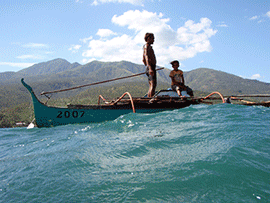Lucy – Was She Living in a Lake Margin?
In the end of June I went to Addis Ababa, Ethiopia, were I visited the National Museum. Here the remnants of the world’s most famous fossil, Lucy, can be found. The skeleton is 40% complete and is estimated to be 3.2 million years old.
Lucy was discovered in 1974 near Hadar in Ethiopia, by Donald Johanson and his colleague Maurice Taieb. She was classified as Australopithecus afarensis.Donald Johanson and others have suggested that Lucy had been living in a mosaic environment (forests, grasslands, lakes). However, the fossil of Lucy was found next to crocodile and turtle eggs and crab claws (Johanson & Taieb 1976).
Today the excavation site lies in a dessert, but 3, 2 million years ago the area were green and flourishing. Many scientists have suggested that Lucy fell in to a lake after she died – but perhaps lake margins was the biotope she preferred? Probably she was actually feeding from the lake.
Throughout the years, the so called Aquatic Ape Theory has been ridiculed – even if the most famous fossil was found next to crocodile eggs and crab claws.
However, the distinct adaptation to a water-based lifestyle took place later. Homo Erectus was probably much more adapted to an littoral environment than her Australopithecine forefathers – as a swimmer and free-diver (see earlier posts).
In the National Museum of Ethiopia you can also find see the skulls of Omo 1 and Omo 2, the oldest fossils of Homo Sapiens ever found. They are estimated to be around 190 000 years old. Today, the Omo Valley of Ethiopia is one of the most unique places on earth because of the wide variety of people.
References
Johanson, D.C., and Taieb, M., 1976, Plio-Pleistocene hominid discoveries in Hadar, Ethiopia: Nature, v. 260, p. 293–297









It’s now generally acknowledged that Lucy (Au.afarensis) was probably no direct ancestor of ours (in fact, IMO there are arguments suggesting that afarensis might have been more closely related to gorillas than to chimps or humans). Virtually all fossils of Au.afarensis-aethiopicus-boisei come from swamp forests, papyrus swamps, lagoons & wetlands, where they seem to have fed on floating plants (eg, papyrus) & animals (snails, shellfish). Lowland gorillas still spend 1 or 2 hours per day in forest bais, feeding on AHV (aquatic herbaceous vegetation).
As you say, the lit(t)oral theory (AAT in the strict sense) was probably mostly about archaic Homo populations during the Pleistocene (Ice Ages), dispersing along the coasts (exposed continental shelves then) & later rivers in Eurasia & Africa.
The scientific journal Human Evoluiton will soon devote 2 special editions to the litoral theory:
Human Evolution – Proceedings of the Symposium held in London on 8-10th May 2013 “Human Evolution: Past, Present & Future”
SPECIAL EDITION PART 1 (end 2013)
Introduction – Peter Rhys-Evans
1. Human’s Association with Water Bodies: the ‘Exaggerated Diving Reflex’ and its Relationship with the Evolutionary Allometry of Human Pelvic and Brain Sizes – Stephen Oppenheimer
2. Human Ecological Breadth: Why Neither Savanna nor Aquatic Hypotheses can Hold Water – JH Langdon
3. Endurance Running versus Underwater Foraging: an Anatomical and Palaeoecological Perspective – Stephen Munro
4. Wading Hypotheses of the Origin of Human Bipedalism – Algis Kuliukas
5. The Aquatic Ape Evolves: Common Misconceptions and Unproven Assumptions about the So-Called Aquatic Ape Hypothesis – Marc Verhaegen
6. The Epigenetic Emergence of Culture at the Coastline: Interaction of Genes, Nutrition, Environment and Demography – CL Broadhurst & Michael Crawford
SPECIAL EDITION PART 2 (begin 2014) with 12 contributions
November 18, 2013 at 12:35 am